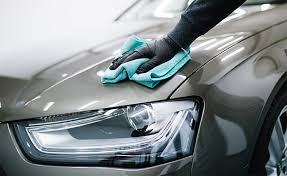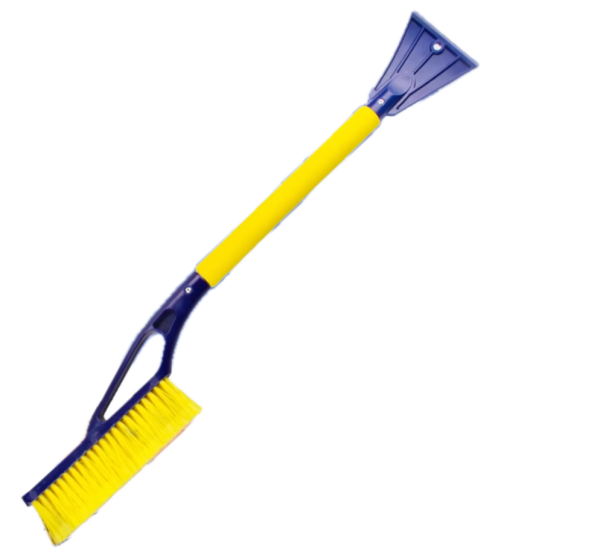How to defrost car windows?
How to remove ice and defrost the windows in the car?
Warm water, frost-free and other effective ways to resist the ice crust.
While windshield heating has not become a standard option, winter temperature changes make all motorists suffer without warm garages. But do not rush to get upset — there are many solutions to the problem.
What to use to eliminate ice:
1. Scraper and brush
The most common tools for dealing with ice on glass. With proper handling, they effectively cope with the frozen crust. But with frequent use, especially on modern cars, they lead to the formation of small scratches, which are fraught with glare from the headlights of oncoming cars and the sun.
Ideally, it is better to start working with a scraper after the glass warms up a little with the heater air. So a thin layer of water is formed under the crust, on which pieces of ice will slide well.
When there is no time, you should first crack the crust by walking over it with the back of a scraper with a comb, and only then remove the fragments as usual. This will greatly simplify the task of cleaning the glass and reduce the risk of scratches.
If the scraper is one-sided, you can "cut through" the crust, working not with the entire surface of the tool, but with one of the corners. The ice divided into parts will give in.
2. Heater
The standard method of defrosting with the help of a regular heater works flawlessly, but it is suitable only in cases when there is free time in stock. We'll have to wait until the engine warms up a little and the lower part of the ice layer melts from the warm air. After that, the crust will easily move away, especially if you help it with a scraper.
Many people are afraid to use heating in severe frost, so that the glass does not crack due to temperature changes. In fact, it's almost unrealistic. Theoretically, such a probability exists only in modern cars with electric heaters, thanks to which the heater works even on an unheated engine. But even there, as a rule, the system turns on smoothly and automatically locks at extremely low thermometer readings.
Due to the temperature difference, the glass can crack only if the engine is completely warmed up, without turning on the heater, and then sharply direct the flow of hot air onto the iced glass. Also, the risk is increased by existing cracks from stones or road accidents.
To avoid problems, set the heating temperature to the maximum, the airflow to the minimum and turn on the heater immediately after starting the engine. Until the engine warms up, cold air will blow on the glass. Gradually it will become warmer, and with it, gradually and without sudden changes, the glass itself will warm up.
Additionally, recycling can be enabled. So the heater will not take cold air from the street, but already partially warmed up from the cabin.
3. Warm water
This method is unfairly bypassed by some drivers due to fear of cracking. Nevertheless, warm water can completely melt a thin layer of ice, and a thick crust can be lifted and easily moved. The main thing is to act correctly.
Take not boiling water, namely warm water. For example, from a tap or a cooling kettle. The temperature should be no more than 50 ° C, that is, you can hold your hand in it. While you get dressed and get to the parking lot, the water will cool down a little more.
Water the glass from the bottle by opening the lid slightly or making a hole in it. Start from the top and spill each section evenly. For greater effect, you can additionally rub the ice with your hand. The water will quickly melt the frozen layer and will evaporate intensively, and the glass will become clean and dry. If the crust is thick, this method will loosen it, and the ice will be easily removed with a scraper.
Do not overdo it by defrosting the side windows. Water can get under the seal and block the lock mechanism.
4. Glass defroster
Defrosting agent, or anti—ice, is a special chemical for combating ice. It is available in the form of an aerosol or a liquid with a spray gun. The main active component of such products is isopropyl or other alcohol. By lowering the freezing point and releasing heat when reacting with water, it dissolves a thin ice crust, and softens a thick one to the state of porridge.
Such products should be applied to the glass and left for a few minutes. Depending on the thickness of the ice after that, you will either need to turn on the wiper, or get out of the car and brush off the remnants of the ice mass with a brush.
In severe cases, the defroster does not help as effectively. In addition, fluid consumption increases. Well, if the crust is really thick, then it is unlikely to work without a scraper.
5. Non-freezing
The winter glass washer helps in removing ice no worse than special defrosters. In fact, it has a similar composition, but additionally contains cleaning components. It works on the same principle: dissolves the frozen layer, turning it into a mush.
You can simply lift the wiper blades so that they do not rub against the ice, and sprinkle on the glass with a washer from the standard tank or get a container with a non-frost from the trunk and pour it over the ice. But it is better to look for a spray bottle at home and pour the liquid into it. It will be both more convenient and more economical.
6. Alcohol
Ethyl and isopropyl alcohol are the most effective means to combat ice. In fact, it is a defroster concentrate with higher qualities. The freezing temperature of the first substance is -91 ° C, the second — generally -110 ° C.
If there is alcohol at hand, then you can pour it into a container with a sprayer and, spraying, apply it to the ice crust. Almost instantly, it will dissolve and flow down the glass in the form of water. A thick layer of ice gives in more slowly. In order not to waste alcohol, it is better to sprinkle the surface, wait a little, and then remove the remnants with a scraper.
To save money, you can dilute alcohol with water in equal proportions. The freezing point will drop to -25 ° C, but in most cases this will be enough.
How to prevent the formation of ice?
Sometimes it is much easier to eliminate the cause than to bother with eliminating the effect. This also applies to the formation of ice. There are several tips that will help to avoid freezing or significantly reduce it.
1. Ventilate the interior
Before you go home from the parking lot, do not be lazy to open all the doors or windows and ventilate the interior for 3-5 minutes. So the temperature inside and outside will level out, and the probability of icing will decrease. Additionally, you can turn off the heating in advance when approaching the house or even slightly open the window.
2. Cover the windows
If you close the glass with some material, then ice forms on it, not on the glass. Motorists use unnecessary bedspreads, cartons and film for this, pressing them with windscreen wipers and doors. The film fits best because it does not absorb moisture and does not get wet. Due to this, it does not need to be dried and it does not freeze to the glass.
3. Perform hydrophobic treatment
Another option of passive protection is the application of "anti—rain" and other means with hydrophobic properties to the glasses. They repel moisture, preventing it from lingering on the glass, so the maximum that will be on it after a frosty night is loose frost, which is easy to clean even without a scraper.
4. Use wiper protection
Sometimes the glass remains clean, but the wipers' brushes freeze to it tightly. This can be avoided by treating them with silicone grease, which perfectly repels moisture.
Do not forget to turn off the wiper when leaving the car in the parking lot. When the ignition is turned on, it will try to start, and if the brushes are frozen, the motor may break due to the increased load.
It is best to leave the blades in an upright position, having timed the right moment by turning off the ignition. So the water will flow down them without stopping, and they will not freeze to the glass.
MTRAUTO 327
Ice scraper with brush
In order for the car to always remain in excellent condition and its coating is not corroded, it is necessary to remove the formed ice from the surface of the car in a timely manner. To do this, you need to purchase an ice scraper with a TRAUTE 327 brush.





